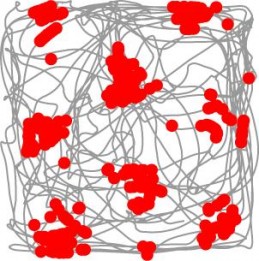Like GPS, the brain’s navigation system for the external world requires precisely timed pulses
April 29, 2011

Red dots signal the location of electrical impulses generated within this grid cell, which are used by the brain to store information about the rat's physical environment (credit: UC San Diego)
Biologists at the University of California, San Diego have discovered that precisely timed electrical oscillations in neuronal “grid cells” in the brain allow us to navigate through our physical environment by maintaining an internal hexagonal representation.
Located in the entorhinal cortex next to the hippocampus, grid cells use precisely timed theta waves from another part of the brain that serves as a kind of neural pacemaker.
The test this hypothesis, scientists monitored the electrical activity of grid cells in rats that explored a small four-foot by four-foot enclosure.
As an animal navigates through its environment, a given grid cell becomes active when the animal’s position coincides with any of the vertices within the grid. The scientists silenced the theta waves by manipulating a small group of pacemaker cells in the brain and observed a significant deterioration of the grid cells’ maps of the environment.
Their discovery has important implications for understanding the underlying causes of neurological diseases such as Alzheimer’s disease and for restoring memory in areas of the brain that are necessary for orientation, the researchers said.
Ref: J. Koenig, A. N. Linder, J. K. Leutgeb, S. Leutgeb, The Spatial Periodicity of Grid Cells Is Not Sustained During Reduced Theta Oscillations, Science, 2011; 332 (6029): 592 DOI: 10.1126/science.1201685